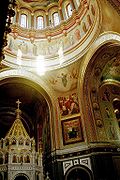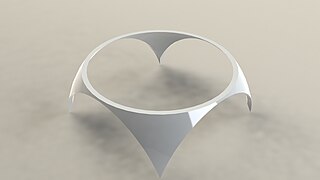Pendentive

The pendentives are shown in yellow.
A pendentive is a constructive device permitting the placing of a circular dome over a square room or an elliptical dome over a rectangular room.[1] The pendentives, which are triangular segments of a sphere, taper to points at the bottom and spread at the top to establish the continuous circular or elliptical base needed for the dome.[2] In masonry the pendentives thus receive the weight of the dome, concentrating it at the four corners where it can be received by the piers beneath.
Prior to the pendentive's development, the device of corbelling or the use of the squinch in the corners of a room had been employed. Pendentives were commonly used in Orthodox, Renaissance, and Baroque churches, with a drum with windows often inserted between the pendentives and the dome. The first experimentation with pendentives was made in Roman dome construction beginning in the 2nd–3rd century AD,[3] while full development of the form was achieved in the 6th-century Eastern Roman Hagia Sophia at Constantinople.[4]
Contents
1 Gallery
2 See also
3 References
4 Sources
Gallery

Arches (left and right), dome (top) and pendentive (centre) in Moscow Cathedral

Holy Trinity Church, Fulnek, Czech Republic

Formation of a pendentive. Eugène Viollet-le-Duc, 1856

A pendentive, labelled A. Illustration of a church in Nantua.

Pendentive structure

One pendentive of the Hagia Sophia main dome
See also
- Hagia Sophia
- Squinch
References
^ The Columbia Encyclopedia, sixth edition
^ "pendentive (architecture) - Britannica Online Encyclopedia". Britannica.com. Retrieved 2012-08-15..mw-parser-output cite.citation{font-style:inherit}.mw-parser-output q{quotes:"""""""'""'"}.mw-parser-output code.cs1-code{color:inherit;background:inherit;border:inherit;padding:inherit}.mw-parser-output .cs1-lock-free a{background:url("//upload.wikimedia.org/wikipedia/commons/thumb/6/65/Lock-green.svg/9px-Lock-green.svg.png")no-repeat;background-position:right .1em center}.mw-parser-output .cs1-lock-limited a,.mw-parser-output .cs1-lock-registration a{background:url("//upload.wikimedia.org/wikipedia/commons/thumb/d/d6/Lock-gray-alt-2.svg/9px-Lock-gray-alt-2.svg.png")no-repeat;background-position:right .1em center}.mw-parser-output .cs1-lock-subscription a{background:url("//upload.wikimedia.org/wikipedia/commons/thumb/a/aa/Lock-red-alt-2.svg/9px-Lock-red-alt-2.svg.png")no-repeat;background-position:right .1em center}.mw-parser-output .cs1-subscription,.mw-parser-output .cs1-registration{color:#555}.mw-parser-output .cs1-subscription span,.mw-parser-output .cs1-registration span{border-bottom:1px dotted;cursor:help}.mw-parser-output .cs1-hidden-error{display:none;font-size:100%}.mw-parser-output .cs1-visible-error{font-size:100%}.mw-parser-output .cs1-subscription,.mw-parser-output .cs1-registration,.mw-parser-output .cs1-format{font-size:95%}.mw-parser-output .cs1-kern-left,.mw-parser-output .cs1-kern-wl-left{padding-left:0.2em}.mw-parser-output .cs1-kern-right,.mw-parser-output .cs1-kern-wl-right{padding-right:0.2em}
^ Rasch 1985, pp. 129f.
^ Heinle & Schlaich 1996, pp. 30–32
Sources
Heinle, Erwin; Schlaich, Jörg (1996), Kuppeln aller Zeiten, aller Kulturen, Stuttgart, ISBN 3-421-03062-6
Rasch, Jürgen (1985), "Die Kuppel in der römischen Architektur. Entwicklung, Formgebung, Konstruktion", Architectura, 15, pp. 117–139
| Wikimedia Commons has media related to Pendentives. |
This architectural element–related article is a stub. You can help Wikipedia by expanding it. |





